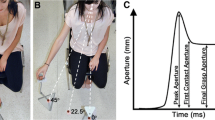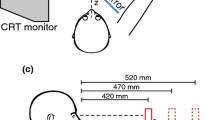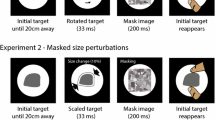Abstract
When humans grasp an object, the thumb habitually contacts the object on the visible part, whereas the index finger makes contact with the object on the occluded part. Considering that the contact points play a critical role in object-oriented actions, we studied if and how the visibility of the points of contact for the thumb and index finger affects grasping movements. We adapted reach-to-point movements (visual feedback displacement: 150 mm in depth) performed with either the thumb or the index finger to measure how a newly learned visuomotor mapping transfers to grasping movements. We found a general transfer of adaptation from reach-to-point to reach-to-grasp movements. However, the transfer of adaptation depended on the visibility of contact points. In the first experiment, in which only the thumb’s contact point was visible during grasping, the transfer of adaptation was larger after thumb than after index finger perturbation. In the second experiment, in which both contact points were equally visible, the transfer of adaptation was of similar magnitude. Furthermore, thumb trajectories were less variable than index trajectories in both experiments weakening the idea that the less variable digit is the digit that guides grasping movements. Our findings suggest that the difficulty in determining the contact points imposes specific constraints that influence how the hand is guided toward the to-be-grasped object.




Similar content being viewed by others
References
Ballard DH, Hayhoe MM, Li F, Whitehead SD (1992) Hand-eye coordination during sequential tasks. Philos Trans R Soc Lond B Biol Sci 337(1281):331–338
Brouwer AM, Franz VH, Gegenfurtner KR (2009) Differences in fixations between grasping and viewing objects. J Vis 9(18):1–24
Cavina-Pratesi C, Hesse C (2013) Why do the eyes prefer the index finger? Simultaneous recording of eye and hand movements during precision grasping. J Vis 13(5):1–15
Coats R, Bingham GP, Mon-Williams M (2008) Calibrating grasp size and reach distance: interactions reveal integral organization of reaching-to-grasp movements. Exp Brain Res 189:211–220
Cressman EK, Henriques DYP (2009) Sensory recalibration of hand position following visuomotor adaptation. J Neurophysiol 102:3505–3518
de Grave DDJ, Hesse C, Brouwer AM, Franz VH (2008) Fixation locations when grasping partly occluded objects. J Vis 8(5):1–11
Desanghere L, Marotta JJ (2011) “Graspability” of objects affects gaze patterns during perception and action tasks. Exp Brain Res 212:177–187
Desmurget M, Vindras P, Gréa H, Viviani P, Grafton ST (2000) Proprioception does not quickly drift during visual occlusion. Exp Brain Res 134:363–377
Galea MP, Castiello U, Dalwood N (2001) Thumb invariance during prehension movement: effects of object orientation. Neuroreport 12:2185–2187
Ghahramani Z, Wolpert DM, Jordan MI (1996) Generalization to local remappings of the visuomotor coordinate transformation. J Neurosci 16:7085–7096
Haggard P, Wing A (1997) On the hand transport component of prehensile movements. J Mot Behav 29:282–287
Hoff B, Arbib MA (1993) Models of trajectory formation and temporal interaction of reach and grasp. J Mot Behav 25:175–192
Jeannerod M (1984) The timing of natural prehension movements. J Mot Behav 16:235–254
Johansson RS, Westling G, Bäckström A, Flanagan JR (2001) Eye-hand coordination in object manipulation. J Neurosci 21:6917–6932
Kenward MG, Roger JH (1997) Small sample inference for fixed effects from restricted maximum likelihood. Biometrics 53:983–997
Marotta JJ, Keith GP, Crawford JD (2005) Task-specific sensorimotor adaptation to reversing prisms. J Neurophysiol 93:1104–1110
Martin TA, Keating JG, Goodkin HP, Bastian AJ, Thach WT (1996) Throwing while looking through prisms. II. Specificity and storage of multiple gaze-throw calibrations. Brain 119:1199–1211
Melmoth DR, Grant S (2012) Getting a grip: different actions and visual guidance of the thumb and finger in precision grasping. Exp Brain Res 222:265–276
Nicolini C, Fantoni C, Mancuso G, Volcic R, Domini F (2014) A framework for the study of vision in active observers. In: Rogowitz BE, Pappas TN, de Ridder H (eds) Human Vision and Electronic Imaging XIX, Proc SPIE, vol 9014, p 901414
Schot WD, Brenner E, Smeets JBJ (2010) Robust movement segmentation by combining multiple sources of information. J Neurosci Methods 187:147–155
Smeets JBJ, Brenner E (1999) A new view on grasping. Motor Control 3:237–271
Smeets JBJ, Brenner E (2001) Independent movements of the digits in grasping. Exp Brain Res 139:92–100
Smeets JBJ, van den Dobbelsteen JJ, de Grave DDJ, van Beers RJ, Brenner E (2006) Sensory integration does not lead to sensory calibration. Proc Natl Acad Sci USA 103:18781–18786
Verheij R, Brenner E, Smeets JBJ (2012) Grasping kinematics from the perspective of the individual digits: a modelling study. PLoS ONE 7(e33):150
Volcic R, Fantoni C, Caudek C, Assad JJ, Domini F (2013) Visuomotor adaptation changes stereoscopic depth perception and tactile discrimination. J Neurosci 33:17081–17088
von Helmholtz H (1867) Treatise on physiological optics. Dover Publications, Dover
Voudouris D, Smeets JBJ, Brenner E (2012) Do humans prefer to see their grasping points? J Mot Behav 44:295–304
Wann JP, Ibrahim SF (1992) Does limb proprioception drift? Exp Brain Res 91:162–166
Wing AM, Fraser C (1983) The contribution of the thumb to reaching movements. Q J Exp Psychol 35:297–309
Author information
Authors and Affiliations
Corresponding author
Rights and permissions
About this article
Cite this article
Volcic, R., Domini, F. The visibility of contact points influences grasping movements. Exp Brain Res 232, 2997–3005 (2014). https://doi.org/10.1007/s00221-014-3978-x
Received:
Accepted:
Published:
Issue Date:
DOI: https://doi.org/10.1007/s00221-014-3978-x




